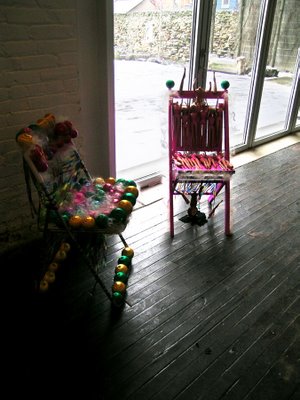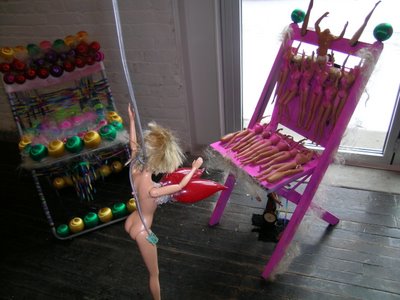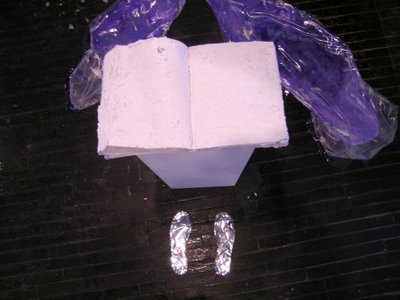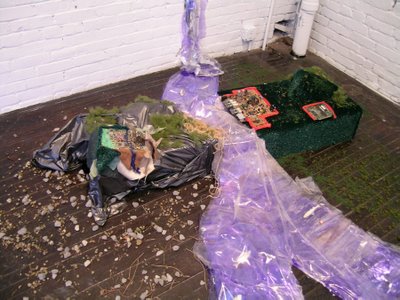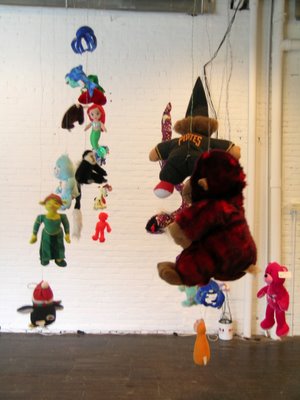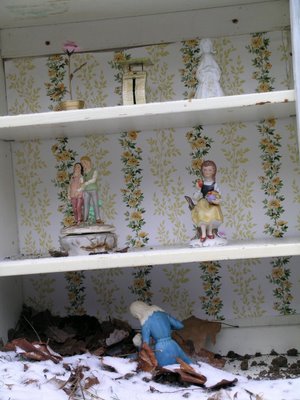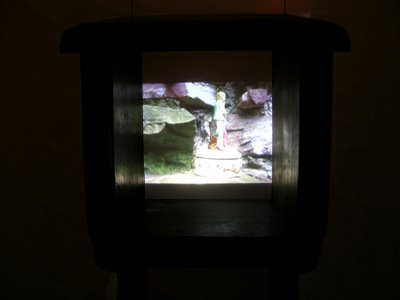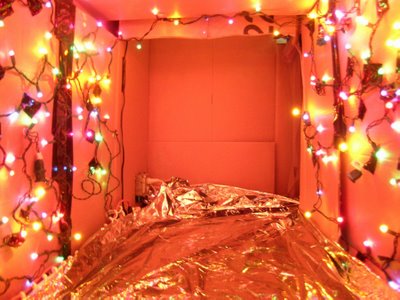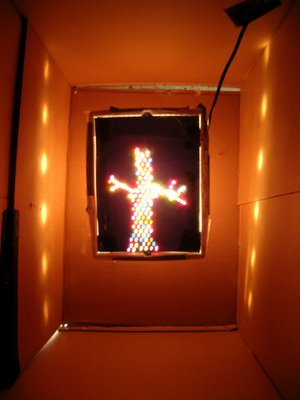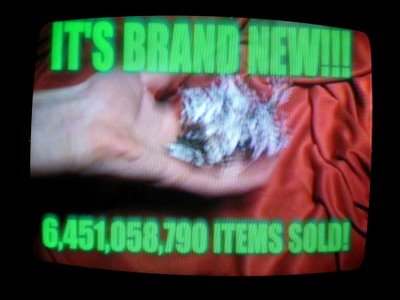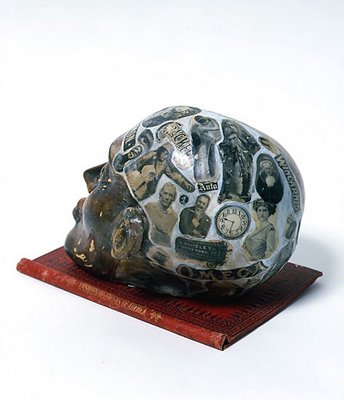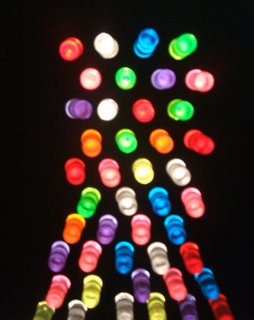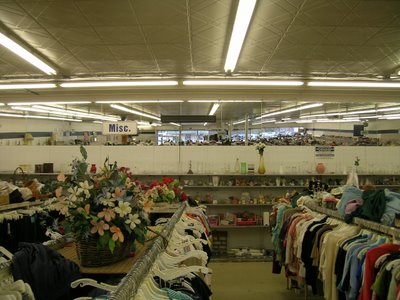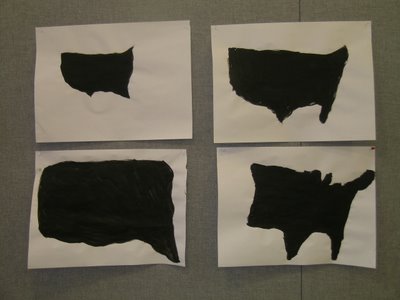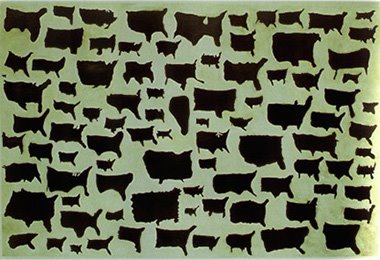Factory 14s: Fall 2006
An environment for creative dialogue created by The Mattress Factory 14s Youth Arts Program. www.mattress.org
Monday, January 22, 2007
Wednesday, January 03, 2007
Thursday, December 21, 2006
New Schedule
Hi Everyone,
There is a lecture with Nick Cave scheduled to take place
on Saturday January 13th at 3pm. I just found out from Anna
this afternoon that they'll be using the main lobby, which is
where we'll be setting up our installations. So....
We decided it may be best to change the opening to January 21.
That way we can set up on Saturday January 20th.
So here's a revised schedule: Ok, this is it now.
Class Added:
Thursday December 28
1-4pm
Saturday December 30
1-4pm
Regular Scheduled Class
Saturday January 6
1-4pm
Regular Scheduled Class
Saturday January 13
1-4pm
Regular Scheduled Class
Class Added:
Saturday January 20
1-4pm
Sunday January 21
2-5pm??
Opening
*Note because we'll have Saturday January 20th
to work, I'm canceling the class on Sunday January 7.
HAVE A GREAT HOLIDAY
Friday, December 15, 2006
Cupido Lupita
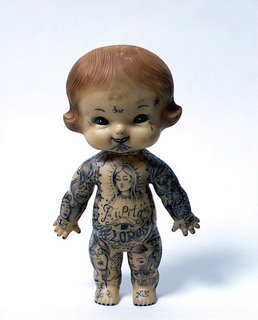
Dr. Lakra
Untitled (Cupido Lupita), 2006
tatooed plastic doll
32 x 19 x 7.5 cm
Dr Lakra, born Mexico 1972, lives and works in Oaxaca, Mexico
Most Oaxacans have a highly adorned day of the dead altar in their homes, including sugar skulls, mementos and skeletons of all sizes doing day-to-day things. These indicate to the dead that they have returned to the right spot, and act a kind of landing pad, with its objects serving as signals to guide the spirits home. Dr Lakra has created his own shrine to the tattoo that is more a homage to kitschy erotica and grotesque fantasy.
Kate MacGarry Gallery
Thursday, December 14, 2006
QuackQgurirkoockadoodlerooQuakcOinkoink
We found this wonderful sock puppet in the education studio + while Ben played the See+Say I made
the puppet speak.
Saturday, December 09, 2006
Vietnamese water puppet show
Múa rối nước is Vietnamese water puppetry. Múa rối nước literally means "puppets that dance on water." The puppets are built out of wood and the shows are performed in a waist-deep pool. A large rod supports the puppet under the water and is used by the puppeteers to control them. The appearance is of the puppets moving the over water. The origin of múa rối nước is debated among scholars. The practice is thought to have originated in the Red River Delta in Vietnam in the Ly Dynasty (12th century). When the rice field would flood the villagers would entertain each other using this puppet form.
Modern water puppetry is performed in a pool of water 4 meters square with the water surface being the stage.Up to 8 puppeteers stand behind a split-bamboo screen, decorated to resemble a temple facade, and control the puppets using long bamboo rods and string mechanism hidden beneath the water surface. The puppets are carved out of wood and often weigh up to 15 kg. A traditional Vietnamese orchestra provides background music accompaniment. The instrumentation includes vocals, drums, wooden bells, cymbals, horns, erhu (Chinese two-stringed fiddle), and bamboo flutes. The bamboo flute's clear, simple notes may accompany royalty while the drums and cymbals may loudly announce a fire-breathing dragon's entrance. Singers of Cheo (a form of opera) with origin in north Vietnam sing songs which tell the story being acted out by the puppets. The musicians and the puppets interact during performance; the musicians may yell a word of warning to a puppet in danger or a word of encouragement to a puppet in need. The puppets enter from either side of the stage or emerge from the murky depths of the water. Spotlights and colorful flags adorn the stage and create a festive atmosphere.
Source- Wikipedia
Friday, December 08, 2006
Thursday, December 07, 2006
Wednesday, December 06, 2006
Saturday, December 02, 2006
Friday, December 01, 2006
Monday, November 27, 2006
Experimental Video #2
An experimental video by Eileen Joseph
Quicktime video with found sound.
23 seconds.
Experimental Video #1
An experimental video by Lindsay Murdoch, Leah Faller and Eileen Joseph.
Quicktime video.
Silent.
56 seconds
Thursday, November 16, 2006
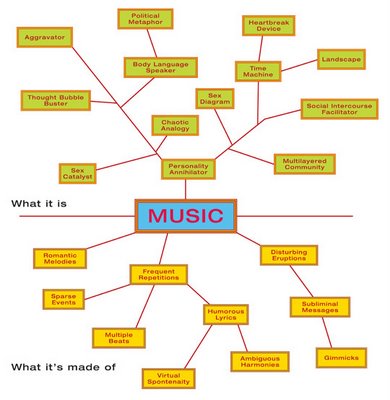
Music: What It Is and What It's Made Of
David Byrne
2002
These are images from David Byrne. You may know of him
from his groundbreaking work with the band Talking Heads,
but also he is a very prolific multi-media / visual artist.
In recent years he has created sound installations,
PowerPoint performance art, many art books and currently
has an exhibition of chair designs: Furnishing the Self —
Upholstering the Soul at Pace/McGill Gallery in NYC.

Tree Drawing (site-specific installation), "What is It?,"
Southeastern Center for Contemporary Art, Winston-Salem,
NC, July 19 – September 26, 2003
Wednesday, November 15, 2006
Factory
By Caleb Foss
Found archive footage
54 seconds
2006
Using footage of a drive in commercial for cigarettes, I edited this not particularly pleasant experimental video. The footage is in the Public Domain and was downloaded from Archive.org
Sunday, November 12, 2006
David Pohl
b. 1963, U.S.A.
Mantra, 2001
phonograph record players, record albums, various found objects.
from the Gestures show at
The Mattress Factory
Pittsburgh, PA
October 27, 2001 - December 8, 2001
Copyright © 2001 David Pohl
House of Pingting Archives
This video is a brief documentation of my installation Mantra, which was in the
first Gestures show at The Mattress Factory - 1414 Monterey Street. Pittsburgh PA
October 27, 2001 - December 8, 2001.
The idea of creating a sound installation had been in my head since 1994,
when I discovered a way to create low-tech analog audio loops by placing
a 45rpm record on top of a 33rpm record. When the needle (playing
the 33) hits the 45, it skips, creating a brief loop. An endless repetition
of the sound recording. I selected various albums including Indian sitar
and vocal music, Indonesian gamelan music, sounds of the ocean, humpback
whales, Sgt. Pepper's Lonely Hearts Club Band, The Broadway Soundtrack
to Hair, Van Morrison's Common One and many others.
Mantra was created during the weeks following September 11th, 2001.
I wanted to create an experimental space for meditation by creating random sound currents to facilitate various meditative states within the viewer/listener. The act of creating the piece also became a devotional act for me and references the Hindu concept of Puja: devotional reverence to God or Spirit-making connection between Individual and Universal Consciousness.
Each morning I would arrive at the piece, and leave an offering on one of the
(record player) altars. Offerings included flowers, incense, ash, fruit, fire, rocks, coins, candy and a large variety of found objects. People also began to leave behind offerings. After making my offering, I would set up the mantra for the day, by creating a series of "loops" with 2-4 records playing at the same time.
Mantra
Source: Wikipedia
The Sanskrit word mantra- consists of the root man-
"to think" (also in manas "mind") and the suffix -tra meaning, tool, hence
a literal translation would be "instrument of thought". Mantras are interpreted
to be effective as sound (vibration), to the effect that great emphasis is put
on correct pronunciation (resulting in an early development of a science of
phonetics in India). They are intended to deliver the mind from illusion and
material inclinations. Chanting is the process of repeating a mantra.
Saturday, November 11, 2006
"Well how do you use minimalistic tools and kick a-- with them?"
For students, it's a brave new world of filmmaking - Pittsburgh...
"You see the connections between YouTube and the birth of the ... know about video through her (Foley's) classes," says student Caleb Foss, of Mt. Lebanon. ..
After today's class, I wanted to view more of Caleb's video work and so, to get to his you tube page, I Googled his name.
I was curious to see if his You Tube videos would appear in the search results. I typed in caleb foss + You Tube. None of Caleb's You Tube videos appeared in the results,
however I was pleased to find a link to an October 18th article in The Pittsburgh Tribune Review, in which he is quoted and in which he discusses The Mattress Factory and many of the ideas which we've been working with. That was a long sentence, but what nice serendipity. Take a minute to read the article click here.
Thursday, November 09, 2006
Tuesday, November 07, 2006
Little Tricker the Squirrel Meets Big Double the Bear
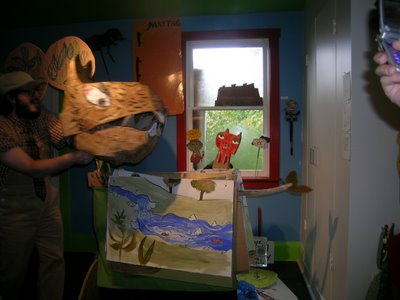
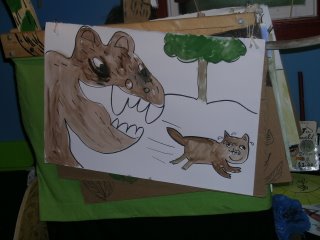
Little Tricker the Squirrel Meets Big Double the Bear
Puppet show at The Tom Museum by Tom Sarver and friends.
410 Sampsonia Way Pittsburgh
October 28, 2006
Tom Sarver is a Pittsburgh based puppeteer, painter and sculptor. He is a member of the Brew House Association and a founding organizer of The Black Sheep Puppet Festival. His work has been featured regionally at Space Gallery, Digging Pitt Gallery, The Hoyt Museum, The Three Rivers Arts Festival, and the Mattress Factory. His puppetry group, The Puppet Express performs regularly throughout the Pittsburgh area.
Photographs by Leah Faller
Quicktime video from The Tom Museum
Little Tricker the Squirrel Meets Big Double the Bear
Puppet show at The Tom Museum by Tom Sarver and friends.
410 Sampsonia Way Pittsburgh
October 28, 2006
Tom Sarver is a Pittsburgh based puppeteer, painter and sculptor. He is a member of the Brew House Association and a founding organizer of The Black Sheep Puppet Festival. His work has been featured regionally at Space Gallery, Digging Pitt Gallery, The Hoyt Museum, The Three Rivers Arts Festival, and the Mattress Factory. His puppetry group, The Puppet Express performs regularly throughout the Pittsburgh area.
Tuesday, October 31, 2006
Thursday, October 26, 2006
In the Dwelling House

What Remains
In 2004 the Mattress Factory loaned me 516 Sampsonia for the installation “What Remains.” For this work, I filled the window openings with granite inserts engraved with common cemetery imagery and the names, ages, and occupations of residents of the house circa 1900. The information about the people was gathered from census data, and the information is elegant in its simplicity and the archaic sound of the occupations. The information tells a story, though the details of the story lie in the imagination of the viewer. The people and their lives become the “past you did not know you had” from the Calvino quote. When I moved to Pittsburgh in 2001, having only ever lived in the south, I certainly felt surrounded by a past I never knew I had. What Remains was my way of making a small, overlooked part of that past a bit more tangible.
Ruth Stanford
In The Dwelling House
For “In the Dwelling-House,” I am doing an archaeological investigation of sorts, sifting through the things that previous occupants of the house have left behind. I have gathered a variety of “artifacts” and gone through every room looking for clues in the peeling paint, layers of wallpaper, crumbling plaster, newspaper clippings, etc. I have gone through hundreds of times, sometimes with a flashlight, sometimes with a camera, sometimes on my knees, and I still see something new every time. There is a beauty in the decay and a certain poetry to the way that time and the elements have altered a space that served so long as a home. My goal with “In the Dwelling-House” is simply to highlight a few of the details of the space that I find fascinating as a way to entice the viewer to take their own journey through the time and the space that is 516 Sampsonia.
Ruth Stanford
What Remains
Read the Pittsburgh Post-Gazette Review
by Mary Thomas
Thursday, October 19, 2006
Welcome to The Mattress Factory
Welcome to the Mattress Factory 14s Fall 2006 course:
Working with Installation Art. During the next 14 weeks you will experience first hand what it is like to be an artist in residence at The Mattress Factory.
We will meet working artists, take some field trips and investigate the museum's current exhibition and the artists involved. The course will conclude with the completion of a site-specific installation at The Mattress Factory.
Depending on where the interests of the group lead us, we'll explore ideas related to: performance art, sound-based art, video, movement arts, conceptual art, found objects and web-based art- starting with this blog.

James Turrell
Catso, Red (1967), 1994
Permanent Installation
Drywall, paint, xenon projector
The Mattress Factory
500 Sampsonia Way, 2nd floor
Light is a material with a three-dimensional quality in this cross corner projection,from the first series of light works Turrell made as a student.
He has learned to carefully shape (sculpt) light so that it takes on an almost solid form. In Catso, a red cube appears to be suspended in the corner of a room.
Turrell’s work involves explorations in light and space that speak to viewers without words, impacting the eye, body, and mind with the force of a spiritual awakening. “I want to create an atmosphere that can be consciously plumbed with seeing,” says the artist, “like the wordless thought that comes from looking in a fire.”


